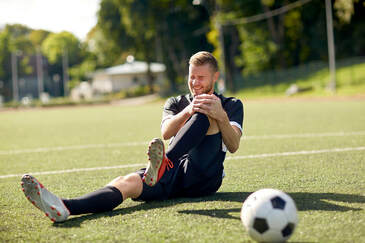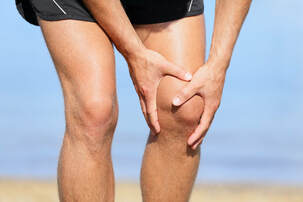 by Dr. Jessica Corbeille Harris, ND Many people deal with chronic pain (and I have a lot of remedies both at-home and in-office for helping with that), but what about those recent injuries (i.e. acute injuries)? What do you do if you sprain your ankle playing soccer tomorrow? Or how about if you tweak your back doing some gardening this evening? Many people have heard of the R-I-C-E acronym for injuries which promotes the use of rest, ice, compression, and elevation. What if I told you those were the exact opposite of what is actually needed for proper healing of the tissue? Instead, when people are injured, I always say, “Ask for your M-A-M-A” – which promotes the use of massage, alternating hot and cold, movement, and arnica to encourage a healthy inflammatory response to allow for proper tissue healing. Generally speaking, most of these are safe for most people, but as for any of my recommendations, if you have any questions or concerns about the safety of the remedies for you, it’s always best to consult your physician.
On the other hand, if your injury is not improving after a day or two or seems to be getting worse over that period, it’s always best to seek medical attention either at the emergency department or with your primary physician. Similarly, if your injury initially improves but you are left with pain or inflammation weeks or months after the injury occurs, it’s also a good time to seek attention from a trained physician to help with this situation. (This may be a good time for some of the prolotherapy treatments I write about as well - check them out here!) Questions? Would you like to discuss your acute or chronic pain/injury? I’d love to connect with you! Check out the Contact page on our site or send me an email at contact@elevatednaturalhealth.com.
2 Comments
by Dr. Jessica Corbeille Harris, ND  What is prolotherapy? Prolotherapy is a type of regenerative joint therapy. By this, I mean that it is a therapy that helps your connective tissues to heal and regenerate thus supporting your joints better. There are a variety of prolotherapy types and all different cocktails of combinations of nutrients that are injected and called, “prolotherapy.” In the case of sore joints and sometimes even sore muscles, often it is the connective tissues – the tendons and ligaments – that are the true root cause of the pain…NOT the “tight” muscles! The connective tissue is not highly vascular, so it does not get good blood supply or delivery of nutrients. Thus, it is easily injured, strained, torn, or degenerated. When the connective tissue is injured, it cannot do its job – so other tissues are recruited to do the work – the muscles and fascia. The muscles and fascia then become tight and are overworked as they work to keep the joints supported and the body moving properly. Overtime, we experience this instability as muscle soreness and pain. With prolotherapies, we are aiming to treat these injured, strained, torn, and/or degenerated tissues and joints with nutrients (like dextrose) and sometimes stronger things like growth factors (in the case of PRP/platelet rich plasma) or even stem cells. Once the connective tissues heal, it takes the workload down for the muscles, so the muscles can go back to just doing their normal job of getting the body to move – not also stabilizing and keeping the body together too. Why does prolotherapy help knee pain? If you’ve injured your knee, chances are you’ve sprained, torn, or otherwise caused extra strain on some of the connective tissues. This causes the muscles around the knee to tighten, as discussed above, to keep your femur (thigh bone) and tibia and fibula (shin bones) together. The muscles get sore and eventually we experience pain. If we can treat the injured connective tissue by testing for and treating the connective tissues (i.e. ACL, MCL, meniscus, etc.), then the muscles can relax and go back to doing their normal job. Does Prolotherapy help other joints too? Absolutely. If there’s a soft tissue injury, prolotherapy can help! Am I a good candidate? People that tend to do the best with prolotherapy are those that generally take good care of their bodies in the first place. Generally speaking, this includes people who participate in moderate exercise 3 or more days per week and eat a whole-foods based diet low in inflammatory foods (like sugar, alcohol, and preservatives) and high in vegetables and fruit. The best way to know if you have connective tissue injury and if you would benefit from prolotherapy is to have an initial consultation with your prolotherapy doctor. What does the treatment look like – is it a “one-shot-wonder”? Dr. Corbeille can determine on the first visit if you are a candidate and if you likely have connective tissue injury. You are welcome to bring imaging results if you have them, though they are not always necessary. Typical treatment plans will be for 3-6 treatments usually at 4-6 weeks apart. Sometimes Dr. Corbeille will recommend PRP or other nutrient additives, depending on your particular condition and overall health. You can expect improvement gradually as you complete the treatments such as improved range of motion, improved function, and hopefully less pain. Dr. Corbeille will always re-evaluate at the end of the treatment plan to determine the next steps for you. _____ Stay tuned for a future post regarding which supplements to start taking now to improve your joint and connective tissue health! |
AuthorThe Doctors at ENH post to this page regularly with new health information, home remedies, and other interesting tidbits. Archives
January 2024
Categories
All
|
DISCLAIMER: THIS WEBSITE DOES NOT OFFER MEDICAL ADVICE. THE CONTENT OF THIS ELEVATED NATURAL HEALTH WEBSITE AND ANY LINKS INCLUDED ARE INTENDED ONLY FOR EDUCATIONAL AND INFORMATIONAL PURPOSES OR TO DESCRIBE THE CLINICS PRODUCTS AND SERVICES. THIS WEBSITE AND ITS CONTENT ARE NOT INTENDED TO PROVIDE PROFESSIONAL MEDICAL ADVICE, DIAGNOSE THE HEALTH CONDITION OF ANY INDIVIDUAL OR SUBSTITUTE FOR PROFESSIONAL GUIDANCE IN THE ADMINISTRATION OF ANY TREATMENT. YOU SHOULD ALWAYS SEEK THE ADVICE OF A LICENSED PHYSICIAN OR OTHER QUALIFIED HEALTHCARE PRACTITIONER REGARDING ANY PERSONAL CONCERNS AS TO SYMPTOMS, MEDICAL CONDITIONS, OR THE USE OF ANY PRODUCTS. SUCH COUNSEL SHOULD NOT BE DISREGARDED OR DELAYED BASED UPON ANY INFORMATION CONTAINED WITHIN THIS WEBSITE. DR. JESSICA CORBEILLE-HARRIS, ND AND DR. MCKENZIE J TIMMER, ND EACH HAVE A DOCTORATE IN NATUROPATHIC MEDICINE AND ARE LICENSED NATUROPATHIC PHYSICIANS IN THE STATE OF WASHINGTON. ANY REFERENCE TO THE PRACTICE OF NATUROPATHIC MEDICINE DOES NOT APPLY IN STATES WHERE NATUROPATHIC MEDICINE IS NOT LICENSED.
Proudly powered by Weebly

 RSS Feed
RSS Feed